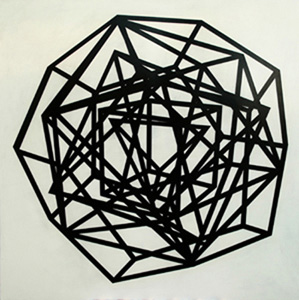
Continuing through December 18, 2010
The contorted and impossible geometries of Garland Fielder's painting and sculpture seem more about Gestalt psychology than Minimalism, even though he claims greater influences by the latter. What sets him apart from Minimalism, both its objects and philosophical practice, is the singularity of each of his objects. Veering far from the one-thing-after-another serial repetition so central to Minimalism, no two are alike in this exhibition.
"Untitled (black contortion 05)" and "Untitled (black contortion 06)" are white cubic geometries on black matte backgrounds. Meticulously rendered, the geometries are almost feasible in reality, but ultimately not. Think here of the Necker Cube or Rubin Goblet, two very well known drawings within Gestalt psychology prized for their illumination of the ambiguities inherent to perception and cognition. A shiny black steel and a painted white polygon, "Untitled (Steel Octahedron)" and "White Cube" do not so much sit on the floor as seem embedded in it. Where each object hits the floor edges and corners go missing. Unconcerned with the core philosophy of Minimalism, the intention of which was to bring a hammer down on the old humanist conventions of truth and beauty, Fielder's pieces are more than anything else delectable formal objects.
Holly Johnson
